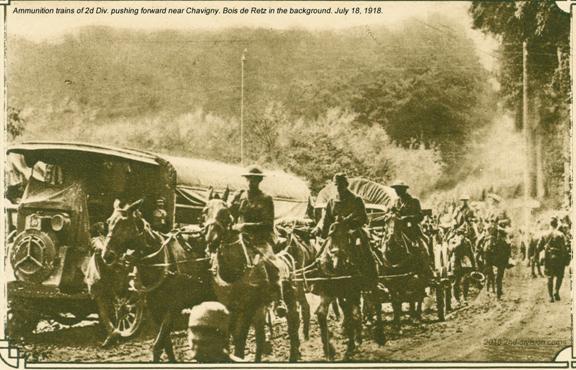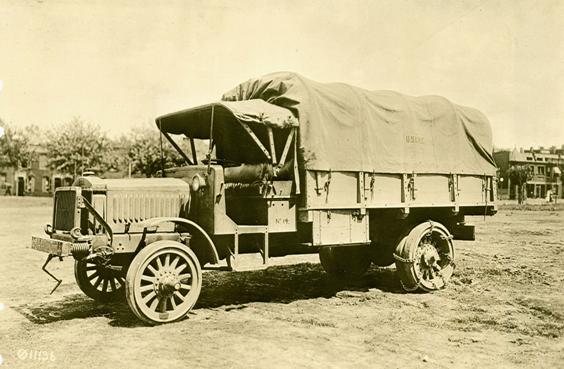Men + Horses + Trucks = Trains
Supply Trains
It was a challenge to stretch the Army's supply lines across the Atlantic, as well as across the country, in order to sustain 4,000,000 soldiers. To bring the supplies to the fight, once in France the Corps would need men to organize supply depots, keep trucks running, keep horses shod, drive wagons or trucks, and load and unload supplies - and all of them might have to do their jobs while under enemy fire. In order to keep a Regiment constantly prepared for combat, the U.S.Q.M.C. provided it with one or more "Supply Trains." This was equivalent to the Regiment's having its own FedEx operation(s), complete with vehicles, a warehouse or two, and personnel. Supply Trains acquired and stocked everything their "customers" required: food, cooking utensils, shoelaces, gas masks, etc. Deliveries were made wherever and whenever supplies were needed. Usually, medical supplies and ammunition were handled by special-purpose Trains (e.g., Charles Wagner served in an "Ammunition Train").
*
Horses vs. Trucks
This war would test the Quartermaster Corps. Teams of horses - its traditional way of moving supplies - could pull loaded wagons only about eight muddy miles. With enemy artillery reaching further than before, many supply depots would have to be located further than eight miles from combat.

Motor power and horse power move side-by-side.
That's NOT a Mercedes logo on the left; it's the French-built truck's Solex radiator.
2nd-division.com
Army "brass" was skeptical about relying on motor trucks instead of animals. High-capacity trucks were new and unproved. They required spare parts, gasoline, and mechanics, and they could not go off-road as easily as horses. Not fully confident in either animals or trucks, the Army used both during the war.
One Truck to Rule Them All?
No one manufacturer could build enough heavy-duty trucks for the entire Army, so the U.S.Q.M.C. bought a variety of them, trained its mechanics to fix each variety, and bought spare parts for all of them. Such diversity was a liability, as wartime maintenance would be frequent.
To resolve this issue, the U.S.Q.M.C. worked with a group of manufacturers to design a standard truck, which could be built by multiple corporations using identical critical parts. For example, a defective radiator (or even an entire engine) in a truck could be replaced by a similar component produced by any of the manufacturers.
Eventually, orders were placed for over 52,000 such trucks.

First-series Liberty Truck; "U.S.Q.M.C." can be seen stenciled on the tarp
Wikipedia
Dubbed "Liberty Trucks," the vehicles seemed to work well, but none reached France until October 1918, and almost none served in the war. At war's end, the more than 40,000 orders still outstanding were canceled.
***

